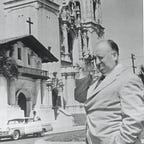Unit 5: Medieval Christianity, Liturgy, and the Aesthetic
In Sister Ann Astell’s book, Eating Beauty, one gains an understanding of this title in both the physical and spiritual sense of the Eucharist. She states that, “To see the consecrated Host, for it was -Christ- , was to see it with the eyes of faith; to hear, to smell, to taste and ultimately touch Christ and be touched by Him. At the base of all the physical senses, touch was paradoxically at the pinnacle of the spiritual senses”(pg.3–4). Ultimately, Christ in the Eucharist restores us.
Sr. Astell explores the Eucharist: its place and purpose in our faith journey.
In chapter she delineates Saint Albert view that the Eucharist is beautiful, grace filled, transformative and, above all, redemptive. The Eucharist is the “sacrament of sacraments” because it is “through the sacrament of the altar, the faithful receive, first of all the grace of Communion, with their fellow Christians; … souls are cleansed” (pg56). Saint Albert’s explanation itself is beautiful when he says that Christ in the “Eucharist is a nourishing seed, when consumed physically, it sprouts and grows spiritually and matures the soul gradually, opening one to a closer relationship with Christ.” Additionally, Saint Augustine states that “we are fashioned and refashioned, we are assimilated to the Son of God” (pg57). “Eating” the Eucharist is the most beautiful gift God bestows on us as it transforms us to be more Christ-like, more beautiful just as St. Francis of Assis became in the middle ages and St. Edith Stein in our modern era.
Adam and Eve’s story of consuming the forbidden fruit from the tree of knowledge highlights the difference between the “apple” that leads to death and the Eucharist that leads to life. Sr. Astell points out that in the works of the medieval authors Adam and Eve’s sin was caused by the following four: pride, disobedience, avarice and gluttony. She states that the “eucharistic species” negates those “sins” exemplified in the monastic humility, the Franciscan poverty, the Dominican preaching and fasting, and Jesuit obedience. She continues to say that “each is restorative of a paradise lost, an approach to a heaven to come”(60–61). Thus, the Eucharist is the food that reverses the spiritual decay of the “apple”.
One of the spiritualities that intrigued me was the Franciscan spirituality and its Saint Francis of Assisi because having grown up in San Francisco and at a parish founded by Franciscans, that spirituality has influenced me since grade school. We began each morning and closed each school day with the Prayer of Saint Francis. Therefore I appreciated, Sister Astell’s chapter “Adorned with Wounds’’. Her focus on Saint Bonaventure’s book Legenda Maior: The Life of Saint Francis of Assisi really encapsulates the beauty of St. Francis with the book itself is a visual relic. Overall Saint Francis in his renouncing of all material things tried his best to imitate the life of Christ. In doing so, he opened himself up to be spiritually transformed into Christ. Saint Bonaventure points out that anyone can imitate Saint Francis in his transformation to be more Christ-like because every creature in existence is originally created in beauty. Therefore, everyone with God’s grace can be transformed to be Christ-like. Sister Astell notes that, “in the Legenda Christ’s outward carving of Francis through the stigmata comes as a confirmation of a life of penance by means of which Christ’s grace had already made Francis a work of art”(pg.118). Sister Astell reminds us that even the individual is God’s work of art that leads others to Christ.
As mentioned in the course video’s interview between Sr. Astell and Dr. O’Malley, this book is extremely relevant today. With the COVID-19 pandemic everyone had to pivot their lives, that included their jobs, schools, and church, from in-person to “virtual” Because of the forced shelter in place mandate, faith communities could only celebrate the mass virtually, and, therefore, receive Eucharist, reciting “The Act of Spiritual Communion”, also commonly practiced in the middle ages. In Sr. Astell’s last chapter she also shared Saint Edith Stein’s practice of Eucharistic adoration which is the “focused glance of the eyes to the consecrated Host and the soul of Christ is a means to the highest level of union with God ‘’. (pg.255). Since the beginning of the pandemic, Fr. Francis Garbo, Mission Dolores’ pastor, has offered three times a week an Eucharistic Holy Hour via livestream. Even this virtual modern gaze of the “consecrated Host” has fed the participants this difficult year. This is what Sister Ann Astell emphasized throughout her book: the Eucharist is transformative involving all the senses, nourishing and replenishing the faithful.
